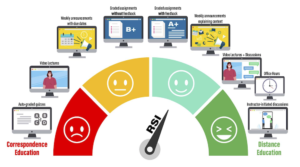
OSCQR – Standard #46
Criteria for the assessment of a graded assignment are clearly articulated (rubrics, exemplary work).
Review These Explanations
Rubrics are recommended as a best practice for communicating criteria and achievement levels for assignments in online courses. Elikai & Schuhmann (2010) found that grading policies and associated rubrics motivated learning by associating levels of mastery and performance with a specific grade, and guiding achievement progress.
According to Worlf & Goodwin (2007), rubrics:
- Make learning targets clearer;
- Guide the design and delivery of instruction;
- Normalize the assessment process; and
- Give learners self- and peer-assessment guidelines.
Guidelines or rubrics for the assessment of graded work should include performance criteria, setting desired performance/proficiency levels for learners, and creating performance descriptions. This includes providing details for what constitutes the continuum of accomplishment, from unsatisfactory through to exemplary, and includes grades associated with each level along the continuum. Criteria for grading schemes (points and percentages) and ranges should be clear (what gets and A, B, and so on), and tie directly to the goals and objectives of the assigned work that is to be evaluated.
Showcasing exemplary work provides learners with a clear example of what outcomes the assignment demands, and what mastery levels need to be reached. Before posting exemplary work, be sure to get permission from the learner whose work you would like to showcase.
References:
Elikai, F., & Schuhmann, P. W. (2010). An examination of the impact of grading policies on students’ achievement. Issues in Accounting Education, 25 (4), 677-693.
Wolf, K. K., & Goodwin, L. L. (2007). Evaluating and Enhancing Outcomes Assessment Quality in Higher Education Programs. Metropolitan Universities, 18(2), 42-56.
Regular and Substantive Interaction (RSI)
How This Standard Supports RSI
This standard can support regular and substantive interaction in the online course design by providing explicit instructions and expectations, rubrics, models/examples, opportunities for peer evaluation, and self assessment, as well as details on how feedback will be provided, when it can be expected, and how course work will be work evaluated. Directing learners to ask questions and interact with the instructor about course assignments, activities, and the related grading criteria and expectations, such as in an online discussion forum, further supports RSI, and is a good general practice. Scheduling specific instructor-facilitated discussion in groups, or in private Office Hours with individuals, to discuss course content, activities, assignment feedback, provide help, answer questions, and/or get clarification demonstrates compliance with RSI.
Refresh Your Course with These Ideas
General Suggestions/Resources
- Create public and private opportunities for interaction with the instructor to ask questions, get help, seek clarification on course assignments, activities, assessments, expectations and grading criteria.
- Use rubrics to provide objective and substantive feedback.
- Provide models and examples of exemplary work to illustrate assignment expectations and rubric criteria.
- Keep a folder of exemplary course work outside of your courses, so that you can access it at any time – even long after a course has ended.
- Use examples of exemplary course work as models in your course, so learners can see an example.
- Designing Authentic Online Assessments
- Assessing Student Learning Online
- Nine Principles of Good Practice for Assessing Student Learning
- Assessing Online Learning
- Tips for Exams and Alternative Assessments
- Alternatives to Traditional Testing
- Online Assessment Techniques (OATs)
- Online Feedback and Assessment (Minilog Video Playlist)
- Fostering and assessing equitable classroom participation
- Five Norms and Five Rubrics for High-Quality Online Learning
- Formative and Summative Assessments
- Peer Assessment
- Self Assessment
Rubrics/Tools:
- Use the rubric features within the LMS.
- Give learners a grading rubric checklist to complete before they turn in any work.
- Review course rubrics from other faculty, or online resources.
- Creating and Using Rubrics for Assessment
- Rubrics
- Using Rubrics
- Authentic Activities, Assessments & Rubrics – ppt.
- Resource Rubric
- Rubistar
- RCampus Rubrics
- Five Norms and Five Rubrics for High-Quality Online Learning
- Synchronous Participation Rubric
- Rubric for Assessing Interactive Qualities of Distance Learning Courses
Examples
Explore More Refreshing Ideas from the Teaching Online Pedagogical Repository (TOPR) at the University of Central Florida (UCF)
This Pedagogical Practice from TOPR explores methods and approaches to providing clear rubrics for learners in support of learner success in online courses.
Explore Related Resources
Share What You Know
OSCQR has been developed by a community of online practitioners interested in quality course design. There are numerous opportunities for community members to offer suggestions, donate resources, and help with future development.
Discuss this standard in the comments section at the bottom of this page.
Contribute your own ideas or refresh resources by filling out the OSCQR Examples Contribution Form.